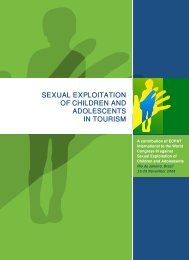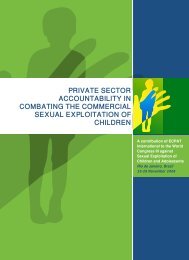to download the document in PDF format - Child Centre: Expert ...
to download the document in PDF format - Child Centre: Expert ...
to download the document in PDF format - Child Centre: Expert ...
Create successful ePaper yourself
Turn your PDF publications into a flip-book with our unique Google optimized e-Paper software.
develop a risk assessment that will look at possible differences between <strong>the</strong> two.F<strong>in</strong>kelhor and Ormrod (2004) found only a modest association of general pornographycrimes with child victimisation. However, Wolak, F<strong>in</strong>kelhor and Mitchell’s (2005) studyof child pornography possessors arrested <strong>in</strong> Internet related crimes <strong>in</strong>dicated that 40% of<strong>the</strong>ir sample were ‘dual offenders’ who sexually victimised children and possessed childpornography. Galbreath, Berl<strong>in</strong> and Sawyer’s (2002) data from 39 Internet offenders<strong>in</strong>dicated that 24% had attempted <strong>to</strong> meet a m<strong>in</strong>or for sex. In contrast, Baartz (2008)exam<strong>in</strong>ed <strong>the</strong> his<strong>to</strong>ries of Australian offenders approached by <strong>the</strong> Australian Federal Police(AFP) between 1 March 2005 and 31 December 2006 (50 <strong>in</strong> <strong>to</strong>tal). There was no evidencewith<strong>in</strong> this data set of <strong>the</strong> production of abusive images, but 14% were apprehended foronl<strong>in</strong>e groom<strong>in</strong>g; 80% of this sample had never been convicted of any type of crim<strong>in</strong>aloffence. A second method, us<strong>in</strong>g self-disclosed data, was demonstrated by Hernandez(2000), with a US sample of 62 offenders who were <strong>in</strong> prison for Internet-related sexualoffences. He found that prior <strong>to</strong> treatment, 42% were known <strong>to</strong> be contact offenders with a<strong>to</strong>tal of 55 victims. However, follow<strong>in</strong>g treatment, 76% reported previous contact offencesaga<strong>in</strong>st an additional 1,379 victims. In a subsequent analysis, Hernandez exam<strong>in</strong>ed onlythose offenders whose behaviour related <strong>to</strong> abuse images. Of <strong>the</strong>se 55 offenders, 80%reported previous contact offences. Hernandez (2006) went on <strong>to</strong> exam<strong>in</strong>e <strong>the</strong> data froma second group of 155 adult males convicted of offences relat<strong>in</strong>g <strong>to</strong> abusive images ofchildren, 24% of whom had known previous contact offences. After treatment, 85% of <strong>the</strong>offenders disclosed hav<strong>in</strong>g committed contact offences aga<strong>in</strong>st 1,702 victims. These studieshave not been published <strong>in</strong> peer-reviewed journals and although accepted for publicationby <strong>the</strong> Journal of Family Violence, permission was not given by <strong>the</strong> US Prison Service <strong>to</strong>release <strong>the</strong> data. While criticisms have been made about <strong>the</strong> methods of data collection, itis of concern that – at least <strong>in</strong> prison populations – <strong>the</strong>re may be an underestimate of <strong>the</strong>number of contact offences committed by those who <strong>download</strong> abusive images.As can be seen <strong>in</strong> relation <strong>to</strong> <strong>the</strong> research by Hernandez (2006), one of <strong>the</strong> difficulties <strong>in</strong>mak<strong>in</strong>g comparisons between studies relates <strong>to</strong> <strong>the</strong> populations <strong>the</strong>mselves. This is aptlyillustrated <strong>in</strong> a study by O’Brien and Webster (2007) that described <strong>the</strong> construction, andprelim<strong>in</strong>ary validation, of a measure of <strong>the</strong> attitudes and behaviours of convicted menwhose offences related <strong>to</strong> Internet child pornography (Internet Behaviours and AttitudesQuestionnaire – IBAQ). The pilot stage of <strong>the</strong> study <strong>in</strong>volved 40 men who were <strong>in</strong> prison,whereas Phase 2, <strong>the</strong> validation of an improved version of <strong>the</strong> scale, <strong>in</strong>cluded men who were<strong>in</strong> prison and those whose offence had warranted a community sentence. The data analysis<strong>in</strong>dicated clear demographic differences between <strong>the</strong> two samples. The men <strong>in</strong>cluded <strong>in</strong>Phase 1 were likely <strong>to</strong> be older, and more likely <strong>to</strong> have been arrested as part of a ‘r<strong>in</strong>g’,and were described as possibly a more ‘deviant group’ than those <strong>in</strong> Phase 2. It may be that<strong>Child</strong> Pornography and Sexual Exploitation of <strong>Child</strong>ren Onl<strong>in</strong>e |37




